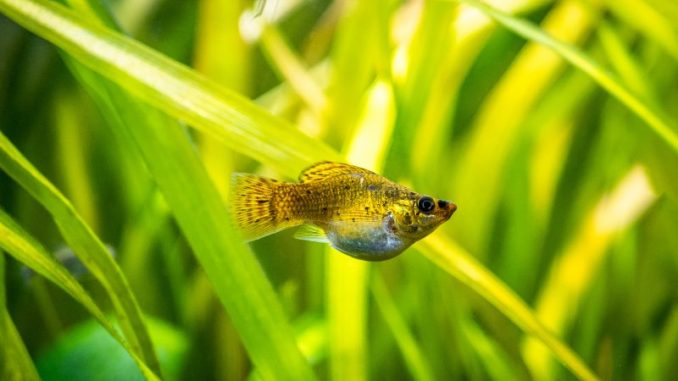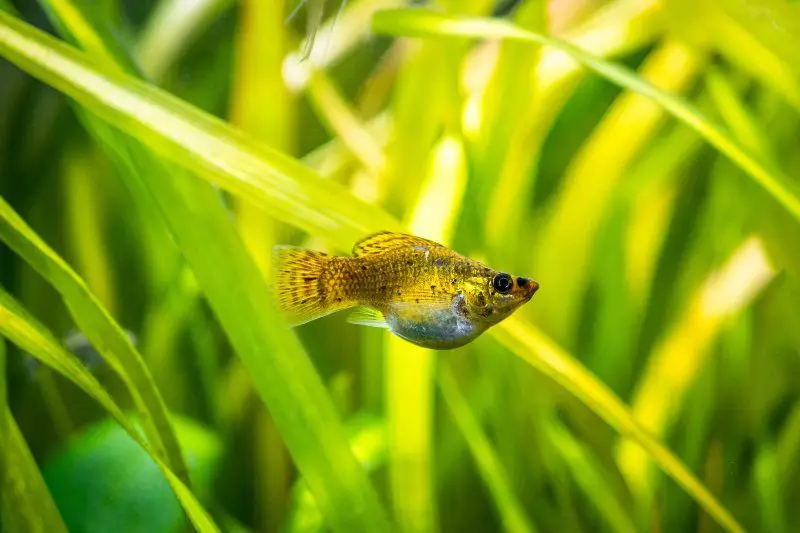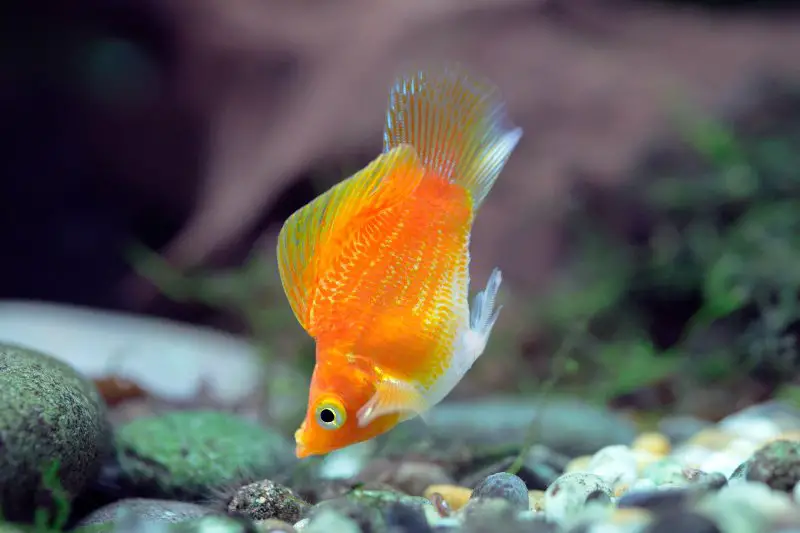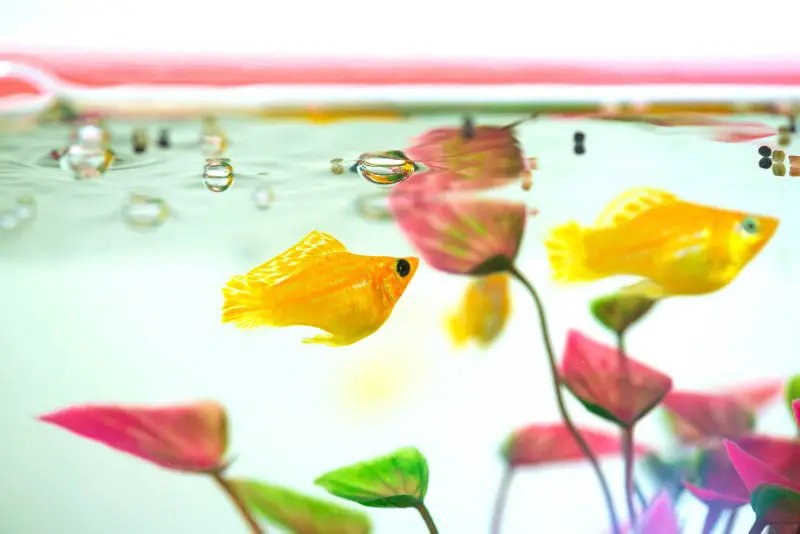
The balloon molly is a freshwater fish from the Poeciliidae family. The breed’s distinctive physical appearance makes it a popular species in home aquariums. The man-made species were specifically bred to have scoliosis, a deformity that causes the fish’s noticeably arched back and protruding belly. This colorful creature reproduces quickly and can survive in freshwater or brackish environments.
TABLE OF CONTENTS
Balloon Molly Facts & Overview

| Scientific name | Poecilia latipinna |
| Common name | Balloon molly, belly molly, balloon belly molly |
| Distribution | Man-made |
| Size | 2–3 inches |
| Life expectancy | 2 years |
| Color | Black, white, yellow |
| Diet | Omnivore |
| Temperament | Peaceful |
| Minimum tank size | 25 gallons |
| Temperature | 68–82°F (20–28°C) |
| pH | 7.0–7.8 |
| Hardness | 15–30 dGH |
| Care level | Moderate |
| Breeding | Livebearer |
Origin
Balloon mollies don’t occur naturally because they’re man-made hybridizations of the sailfin molly, a popular variety of molly fish. The molly species originates from Mexico and Central America and can survive in freshwater and brackish (where seawater meets river water) environments.
Adult Size & Lifespan
Adult balloon mollies grow up to 3 inches in length and live for one to two years. Inbred scoliosis gives this molly variety a smaller body than other varieties. Scoliosis gives the balloon molly a barrel-shaped chest and curved spine. The deformity puts significant pressure on the fish’s internal organs and disposes the molly to certain health problems, which is why these fish don’t live as long as other molly varieties.
Some fishkeepers believe that balloon mollies experience discomfort due to their scoliosis, but we don’t know for sure.
Availability
The balloon molly is a popular choice for a home tank because the species is attractive and easy to care for. These mollies can be purchased online, however due to their popularity and reasonable price point, the fish are often sold out.
- LiveAquaria sells balloon mollies for $5.99 each
- PetSmart sells balloon mollies for $5.49 each
Appearance & Behavior

The balloon molly is named for its unique inflated appearance. The fish has a distinctly round belly and arched back. This man-made molly hybrid is typically more colorful than mollies found in the wild.
Colors, Patterns, Fins, and Sex Differences
The female balloon molly has rounded fins and a short triangular anal fin. The male has a sail-like dorsal fin spine and its anal fin is long and pointed.
Most balloon mollies are bred in shades of yellow, orange, red, white, and black. Some have Dalmatian-like spots and marbled patterns in a combination of colors.
Typical Behavior
Balloon mollies are peaceful, friendly, and only show aggression if they are kept in an overcrowded environment or paired with overly aggressive tank mates.
Pregnant females are challenging to identify because their naturally protruding bellies hide their gravidity. When ready to give birth, the pregnant female retreats to a dark corner of the tank to have her babies.
Balloon Molly Care & Tank Requirements
Balloon mollies tolerate a variety of water conditions and they do well in a community tank with other fish. Balloon mollies should be given clean water and fed a balanced diet.
Habitat and Tank Requirements
Balloon mollies thrive in tanks with live underwater foliage. The fish hide under foliage to escape predators, and baby balloon mollies find refuge under the plants to avoid being eaten by their parents. Live plants help keep the water clean and contribute to a healthy ecosystem.
These aquatic plants are easy to care for, provide a suitable environment for balloon mollies, and don’t require added CO2:
Tank Conditions
Despite the balloon molly’s small size, the fish produces a substantial amount of waste. Regular tank cleaning is essential for the fish’s well-being. Most veterinarians recommend changing30% of the tank water weekly.
Disease
There are a few diseases that commonly affect balloon mollies in a home tank.
ICH
ICH is an ectoparasite, called Ichthyophthirius multifiliis, that causes visible white spots on the skin and fins of infected fish. Symptoms of ICH include decreased activity, irritability, and loss of appetite. This disease occurs worldwide and is a frequent problem for both fishkeeping enthusiasts and commercial fishermen.
If left untreated, the disease results in 100% mortality. The best ICH treatment is to immediately isolate/quarantine fish with visual symptoms and to introduce approved chemical solutions into the tank water.
Known scientifically as oodinium, velvet is a parasitic disease that’s spread via contaminated tanks and fish. This fish disease is highly contagious and fatal.
Visible symptoms of velvet disease in infected fish include golden-brown lesions on the fish’s skin, sudden darting around the tank, and scratching against objects.
Copper sulfate is usually recommended for treatment, as is turning off aquarium lights throughout recovery. A 70% to 90% water change is required after symptoms have been alleviated.
Fin rot disease is a bacterial infection caused by poor tank conditions. Injured fish are particularly vulnerable. Symptoms include visible white patches on the fins and tail.
To treat fin rot, quarantine the infected fish, administer antibiotics, and change 50% of the home tank water.
Bad tank conditions such as fluctuating temperatures and dirty water can cause protozoan parasites in fish. Symptoms of parasites include excess mucus, loss of appetite, and small white dots on the skin.
To rid parasites in fish, keep a stable water temperature, administer veterinarian-recommended medication, and conduct a 50% to 70% water change after recovery.
Tank Mates

Socializing with the right tank mates helps the balloon molly stay healthy. Keep the mollies with at least three other peaceful freshwater fish. Balloon mollies can’t defend themselves in fights, and shouldn’t be paired with aggressive fish like cichlids and oscar fish.
The following fish make good tank mates for balloon mollies:
Snails and shrimp can also coexist in a community tank with balloon mollies.
Diet and Feeding
Mollies are omnivores and eat almost anything. Serve these fish a pinch of food two times per day to maintain their health. Remove any food that the fish don’t eat within a few minutes to ensure they don’t overeat.
The following foods provide a variety of nutrients to the balloon molly:
- Algae, like hair algae
- Live food, like brine shrimp and mosquito larvae
- Boiled vegetables, like carrots and broccoli
- Blanched leaves, like spinach and lettuce
- Boiled chicken breast
- Commercial flake foods
- Veggie pellets
- Freeze-dried foods, like bloodworms and brine shrimp
Breeding
Balloon mollies are livebearers, which means they carry their eggs inside their bodies and hatch free-swimming babies in the water. Females prefer mating with larger males. The breeding cycle lasts two to five weeks, and the mother produces 40 to 100 offspring.
Breeding balloon mollies is relatively easy. Set up a specific breeding tank with a stable temperature of 76 to 80°F, and maintain a female-heavy ratio of two or three females for every male to avoid male aggression.
- Isolate a male with a female in a specific breeding tank
- Observe the mating ritual to see if the male has flared fins and if the female consents to fertilization
- Wait up to five weeks for the female to give birth
- Remove the parents from the breeding tank so they don’t eat their babies
- Feed the babies flake foods for the first two months
Should You Get a Balloon Molly for Your Aquarium?
Balloon mollies are great fish for new fishkeeping enthusiasts because the fish look attractive in the home aquarium and the species is easy to care for.
If you’re considering giving a new fishkeeper some friendly fish to start their first tank, balloon mollies are an excellent idea!

Be the first to comment